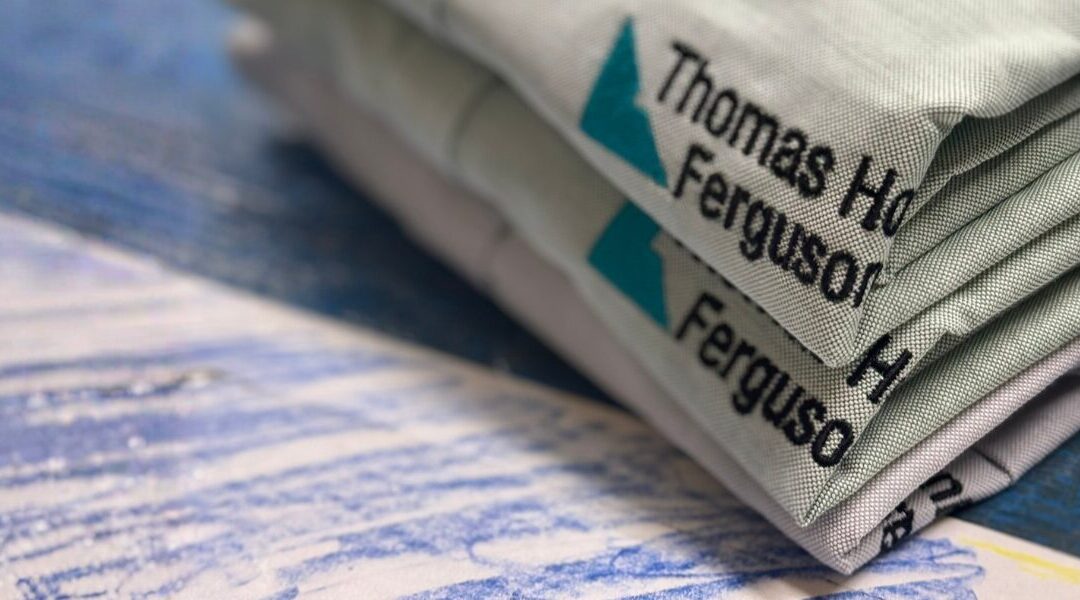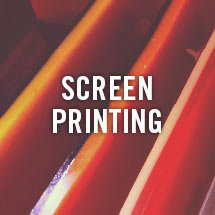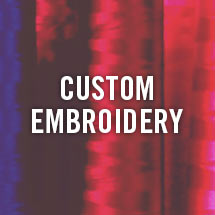If you’ve ever ordered custom branded apparel for your business, school, nonprofit or rec team, you know the process can feel daunting. Picking out a T-shirt may sound simple until you realize how many options exist for fabric, printing method, design and more. Cotton, polyester, blends, tri-blends and performance fabrics each bring unique advantages and drawbacks. In addition, not every fabric works with each printing method, further complicating the process.
For small business owners, the stakes are high. Branded apparel is a walking advertisement for your brand, whether you’re creating uniforms or giving away shirts at a community event. The fabric you choose will directly affect how long your branded apparel lasts, how comfortable it feels to wear and how professional it looks.
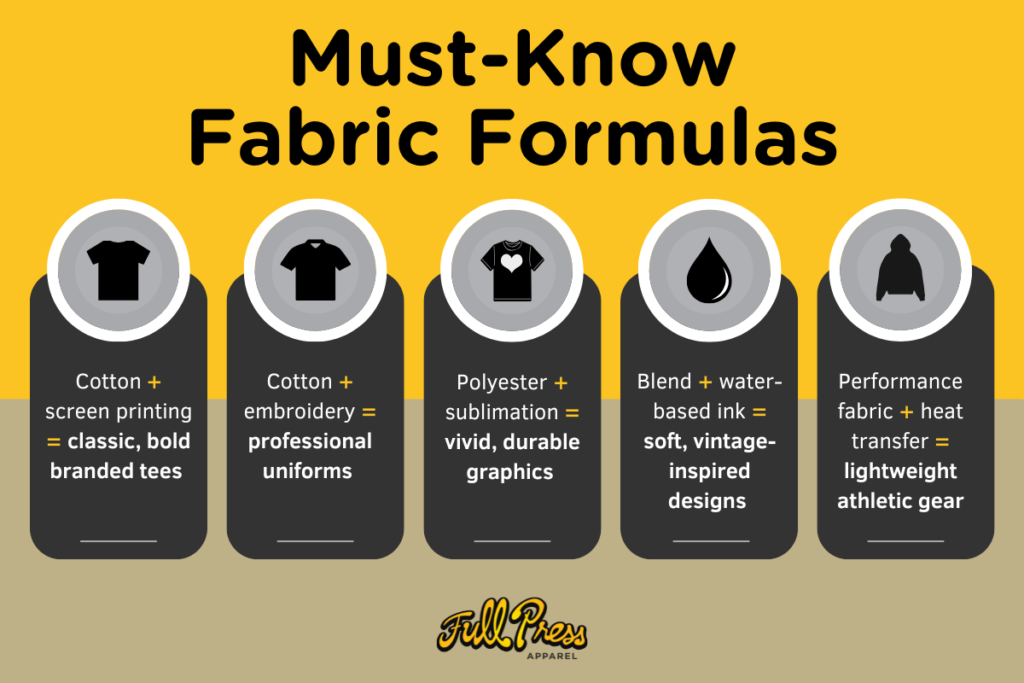
Fabric Basics
Before diving into the details of each fabric, it’s important to understand why it is so crucial to the success of your branded apparel.
- Durability: Each fabric has a different lifespan, with some more durable than others. Each fabric needs different care and will withstand different uses, an important factor when considering your branded apparel.
- Comfort: Is the fabric you’re choosing breathable, soft and suited to your climate? The comfort offered by cotton is distinct from that of performance athletic fabrics, and choosing the most comfortable fabric for your customers’ lifestyles is vital to successful branded apparel.
- Print Quality: Certain fabrics take ink better than others, with sharper, bolder colors. However, inkless printing methods might better suit your favorite fabric.
- Professionalism: Different fabrics give different impressions of your brand. Some look more polished and elegant, some more casual.
Cotton: A Timeless Classic
Cotton is the most common fabric choice for branded apparel. It’s affordable, breathable and has been trusted for hundreds of years. Cotton shirts tend to be soft and comfortable, making them perfect for giveaways, fundraisers and more casual uniforms.
Best Printing Pairings
- Screen printing: Cotton absorbs ink well, producing bold and durable designs when screen printed.
- Embroidery: Cotton has a stable surface for stitching and logos, though overdone or heavy embroidery may weigh down lighter cotton shirts.
Pros
- Affordable
- Breathable
- Comfortable
- Works with most decoration and printing methods
Cons
- Shrinks in the wash unless pre-treated
- Wrinkles easily
- Fades over time
Key Takeaway: Cotton works best for event T-shirts, casual work uniforms and affordable promotional giveaways.
Polyester: The Durable Choice
Polyester has exploded in popularity in the last few decades, especially for athletic wear and durable branded apparel. Unlike cotton, polyester is wrinkle-resistant, shrink-proof and moisture-wicking. Polyester is the fabric of choice for performance apparel, where comfort and durability are the most important factors.
Best Printing Pairings
- Dye Sublimation: Polyester excels alongside dye sublimation printing. Sublimation embeds ink into the fabric, resulting in a vibrant, long-lasting design. Sublimation printing also works better for all-over designs.
- Heat Transfer: Polyester responds well to heat transfer printing as it uses heat and pressure to apply logos and artwork onto garments using transfer paper. Heat transfer printing is ideal for smaller printing runs or specialty graphics.
Pros
- Durability
- Retention of shape and color
- Moisture-wicking
Cons
- Less breathable than cotton
- Can feel less soft to the touch
- Not ideal for screen printing as ink does not properly adhere
Key Takeaway: Polyester is ideal for sports teams and outdoor events, all-over designs and performance branded apparel.
Cotton-Poly Blends: Bridging The Gap
Cotton-polyester blends combine the softness of cotton with the durability of polyester. 50/50 blends are most common, but other ratios are available for unique balances of comfort, cost and longevity. Blended fabrics are more versatile, a safe choice for businesses that want durable apparel without sacrificing classic comfort.
Best Printing Pairings
- Screen printing: Though colors may not pop as much as on 100% cotton fabric, screen printing is effective for cotton-poly blends and provides a long-lasting final product.
- Water-based inks: These inks create a softer, vintage-inspired look that suits cotton-poly blend fabrics.
Pros
- Balances comfort and durability
- Less shrinkage than plain cotton
- Wrinkle-resistant
Cons
- May not print as vividly as 100% cotton fabrics
- Slightly higher cost
Key Takeaway: Cotton-poly blends are best suited for employee uniforms, branded tees where durability matters and more versatile everyday apparel.
Tri-blends: A Premium Experience
Tri-blends combine cotton with polyester and rayon to create a lightweight, ultra-soft fabric with a premium, luxurious feel. Tri-blend garments drape well, making them more flattering and suited for trendy branded apparel.
Best Printing Pairings
- Screen printed with water-based ink: This process provides a soft, more vintage-inspired finish that suits this more high-end fabric.
- Embroidery: This method is best for stitching logos onto a tri-blend garment, but more extensive embroidery can be tricky on thinner fabrics.
Pros
- Soft and comfortable
- Stylish and modern
- Lightweight
- Breathable
Cons
- More difficult to print on
- More expensive than cotton or simpler blends
- May not last as long with heavy use
- Works best for premium giveaways, creating retail-quality merchandise and brands targeting younger or trendy audiences.
Key Takeaway: Tri-blends are ideal for businesses wanting a retail level of quality for their branded apparel.
Performance Fabrics: Built for Action
Performance fabrics are often polyester-based and are designed for moisture-wicking, stretch and breathability. Performance fabrics are perfect for athletic wear and uniforms where employees’ comfort is crucial.
Best Printing Pairings
- Heat transfer: Does a good job with numbers, names and simpler logos
- Dye sublimation: Produces vivid designs without adding any weight
Pros
- Lightweight and breathable
- Moisture-wicking
- Built for movement and fitness activities
Cons
- Less soft than cotton
- Printing options are more limited than other fabrics.
Key Takeaway: Performance fabrics are a good choice for sports teams, fitness agencies, company sponsored athletic events and more.
Fabric Formulas
Choosing the perfect fabric for your branded apparel is easier when you think of it as a formula:
Fabric + Printing Method = Outcome
Here are a few common combinations to guide your decision.
- Cotton + screen printing = classic, bold branded tees
- Cotton + embroidery = professional uniforms
- Polyester + sublimation = vivid, durable graphics
- Blend + water-based ink = soft, vintage-inspired designs
- Performance fabric + heat transfer = lightweight athletic gear
These formulas can help small businesses navigate how fabric and printing choices impact their final branded apparel designs.
Where Branded Apparel Works Best
Different organizations and events have different needs, so your fabric choice should align with these goals.
- Corporate events: Cotton or cotton-poly blends work for affordable, comfortable tee shirts.
- School fundraising: Cotton offers affordability, while a tri-blend can add style for higher-value branded products.
- Sports teams: Performance fabrics provide excellent durability and comfort for outdoor and athletic use.
- Employee uniforms: Cotton-poly blends balance comfort, durability and professionalism for daily wear.
By thinking more strategically about the best fabrics for branded apparel, you can avoid expensive mistakes and ensure your promotional clothing delivers measurable value.
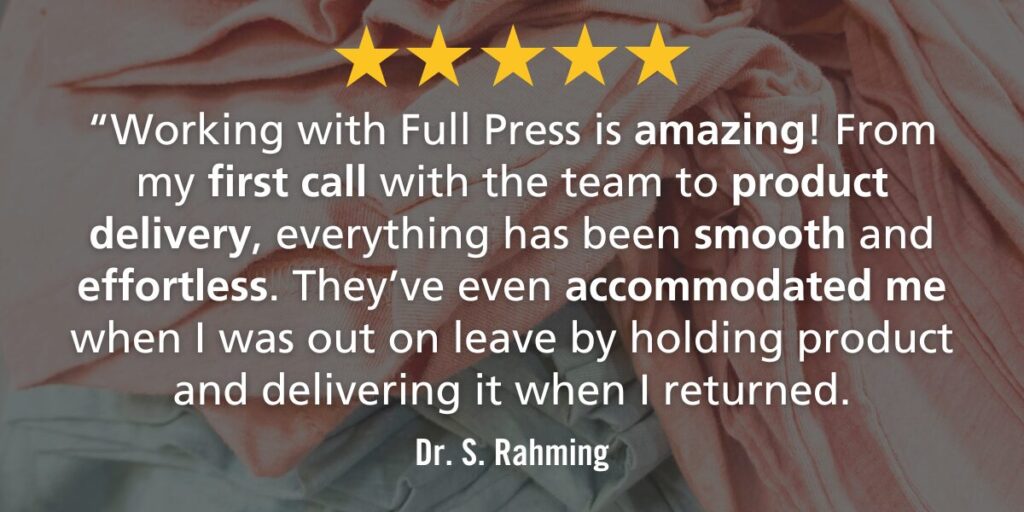
Work with the Experts
Choosing the best fabrics for branded apparel is vital to creating effective marketing impact. Cotton is timeless and low-cost, polyester is modern and durable, blends balance comfort with strength, tri-blends provide a premium experience and performance fabrics deliver for active and outdoor use.
Each of these popular fabrics has a role to play in the design and creation of branded apparel, especially depending on your business’s goals, budget and audience. For small business owners, the challenge is often applying this information to the right decisions for a specific project. That’s where experience comes into play.
For over 20 years, Full Press Apparel has helped businesses, schools and other organizations navigate the complexities of branded apparel. Our team understands how fabrics and printing techniques interact to create products people want to wear. From selecting the right fabric to executing the perfectly positioned print, we’ve guided clients through projects of every size and style.
When you partner with us, you get apparel designed with intention. We have outlasted trend cycles, learning and implementing what works best for small businesses. Skip the Stress and Get Great Shirts
Want to skip the stress of designing the perfect T-shirt? From small projects to big orders, Full Press Apparel is backed by decades of experience and commitment to getting it just right. Whether you have a design to tweak or you’re starting from scratch, one of our designers will work with you to create magic.
Call or send us a message today to discuss your big dreams for your organization or brand and how we can make them happen.

